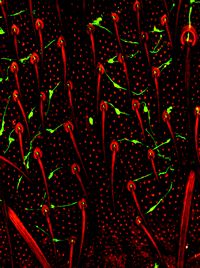UCSD Biologists Uncover Genetic Links To Broad Range Of Human Disorders Resulting From Cilia Dysfunctions
March 13, 2004
By: Kim McDonald
Biologists at the University of California, San Diego have discovered a number of key genes that humans, mice, fruit flies and roundworms all need to produce hair-like cellular protrusions known as cilia -- a structure that when absent or defective in certain cells has been linked to human infertility, blindness, kidney disease and lung dysfunction.

Green neurons at base of red sensory bristles on the thorax of fruit fly.
In a paper featured on the cover of the May 14 issue of the journal Cell, UCSD biologists headed by Charles S. Zuker, a professor of biology and of neurosciences, and postdoctoral fellow Tomer Avidor-Reiss report the identification of some 40 genes that play a role in cilia formation, six of which, they discovered, are essential for the assembly of this cell structure.
"These six genes are fundamentally and universally important for any cell to build cilia," says Zuker, who is also a Howard Hughes Medical Institute investigator, "because if a cell doesn'thave all of them, it is unable to grow cilia."
The discovery of these genes provides medical researchers with a critical new tool to help in diagnosing genetic diseases involving cilia dysfunction and possibly in developing drugs thatcan minimize the health effects of such dysfunctions. .
"This will provide the basic foundation for researchers to understand how cilia form and thegenetic basis for so many of these human genetic disorders," says Avidor-Reiss. "It is only recently that scientists began to realize that there are links between cilia dysfunction and a wide range of human genetic diseases. Now we have an exciting collection of candidate genes."
In humans, sperm navigate toward the egg by propelling themselves with a type of cilia known as flagella. Defects in these whip-like cilia, result in non-motile sperm and male infertility, and are probably the most commonly known type of cilia dysfunctions. Other widely known human cilia disorders include the pulmonary diseases caused by defective respiratory cilia, which cleanse the lungs by sweeping mucous and trapped particles into the throat, and the vision problems or blindness due to defective cilia in the eye's photoreceptors.
In recent years, that list has grown as medical researchers discovered that many human genetic ailments affecting multiple organs have their origin in the absence and dysfunction of cilia. These include polycystic kidney disease, the most common genetic cause of kidney failure; embryonic problems in the body's right-left symmetry that cause organs to develop on the wrong side of the body; and Bardet-Biedel syndrome, a rare genetic disorder characterized by obesity, learning disabilities and eye and kidney problems.
"What was disconcerting about human cilia defects was that, because the physiology of these diseases are so complex and broad, the disorders were not initially tied to cilia dysfunctions," says Zuker. "These people have problems with their retinas, lungs and kidneys. It's only been in the last few years that scientists have understood the etiological basis of some of these human genetic disorders."
Unlike other studies that sought to identify one or two human genes tied to a specific human cilia dysfunction, Zuker's team started with the entire genomes of a wide range of organisms ranging from the unicellular parasite responsible for malaria to humans. The UCSD biologists analyzed more than 150,000 genes using an ingenious computer-analysis strategy, devised by Avidor-Reiss, to search for genes uniquely involved in cilia formation and function. That enabled them to identify approximately 200 genes used by radically different forms of life to build the basic cilia machinery.
Avidor-Reiss narrowed the field of 200 again to 40 genes important for a type of cilia found in human, mouse, fruit fly and roundworm cells, then demonstrated, in a series of experiments in fruit flies, that six of those genes were integral for the formation of cilia. This was done by attaching a fluorescent protein to the proteins produced by the candidate genes that end up at the base of the fly's back bristles, a form of sensory cilia used by flies to sense their position in space and steer as they fly (see photograph).
"Using Drosophila, we were able to demonstrate that all of the genes we have examined were expressed in ciliated cells by tagging them with green fluorescent protein," says Avidor-Reiss. "You could just look at the flies and see them glow."
"What he has now is a list of very attractive candidates," says Zuker. "What we have to do now is to assign functions to them, so we can see how they come together to orchestrate and choreograph the cilia-building and functioning processes. That's going to be a technically demanding, but exciting challenge."
Other researchers who contributed to the study included Edmund Koundakjian and Andrey Polyanovsky, biologists in Zuker's laboratory; Andreia Maer and Shankar Subramaniam of UCSD's San Diego Supercomputer Center; and Thomas Keil of the Max Planck Institute of Biochemistry in Germany. The study was funded by grants from the National Eye Institute and the Howard Hughes Medical Institute.
